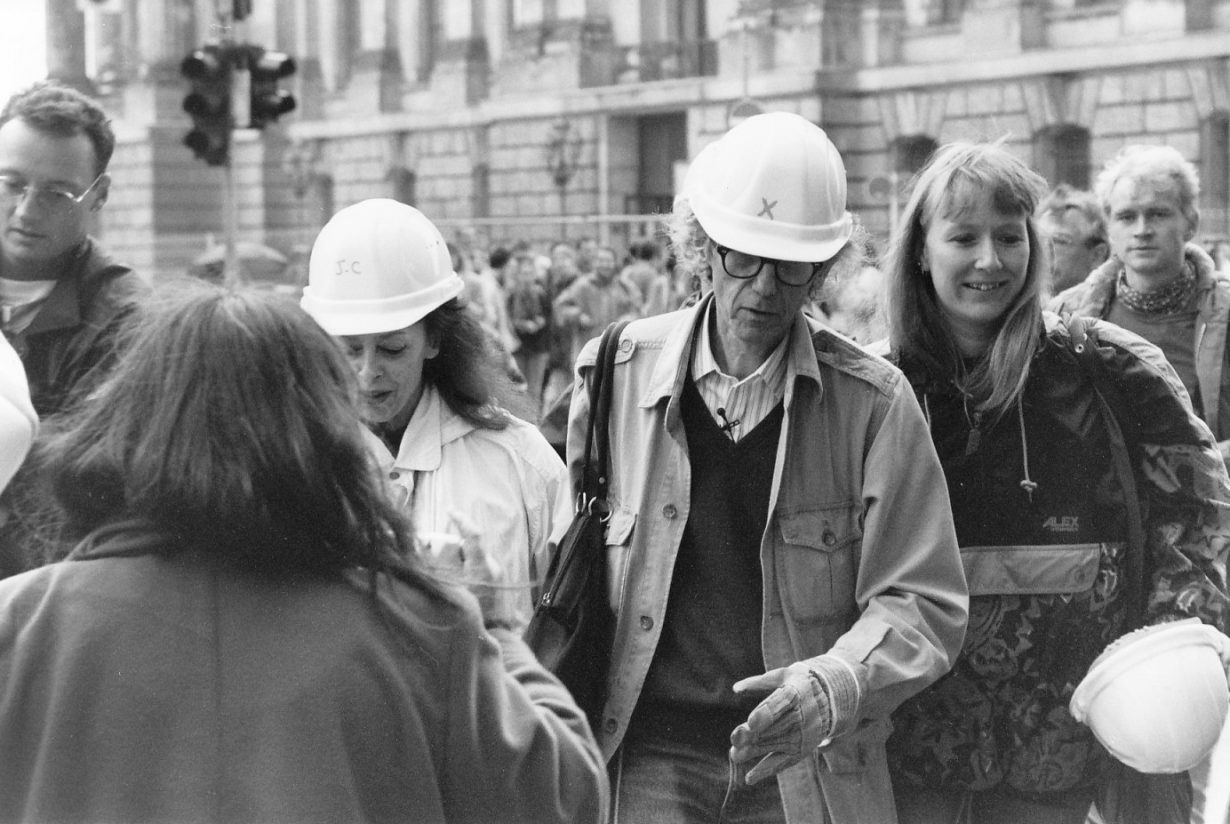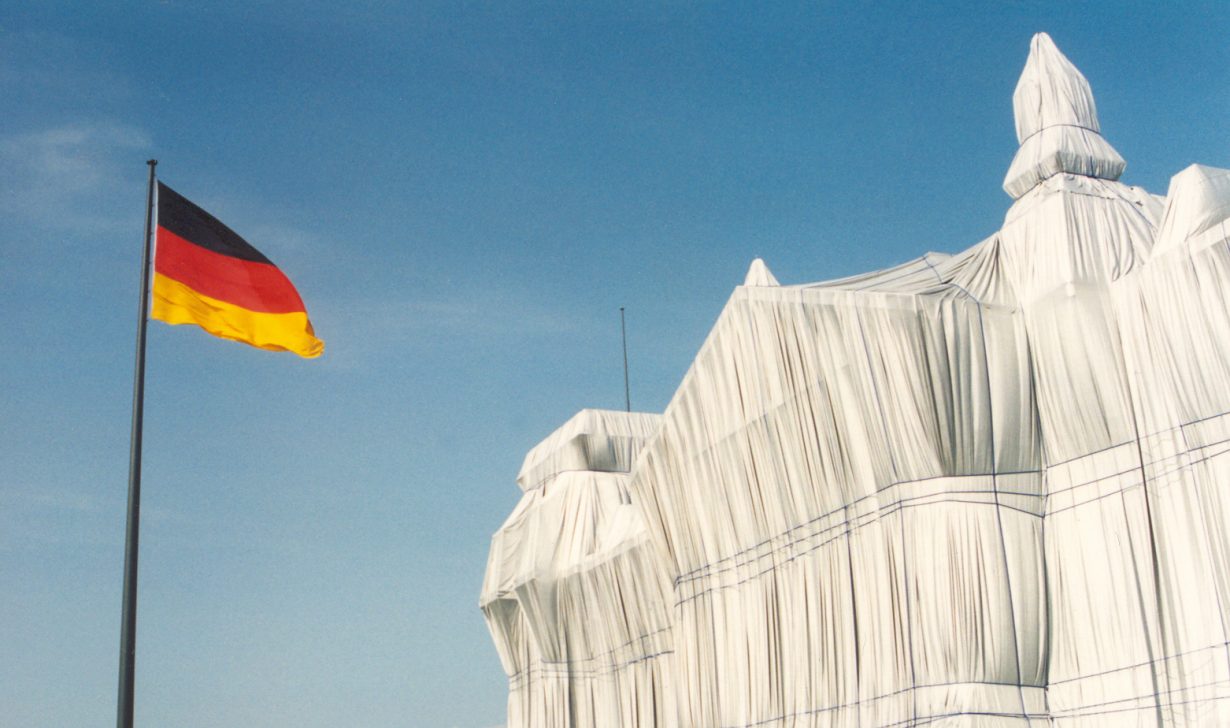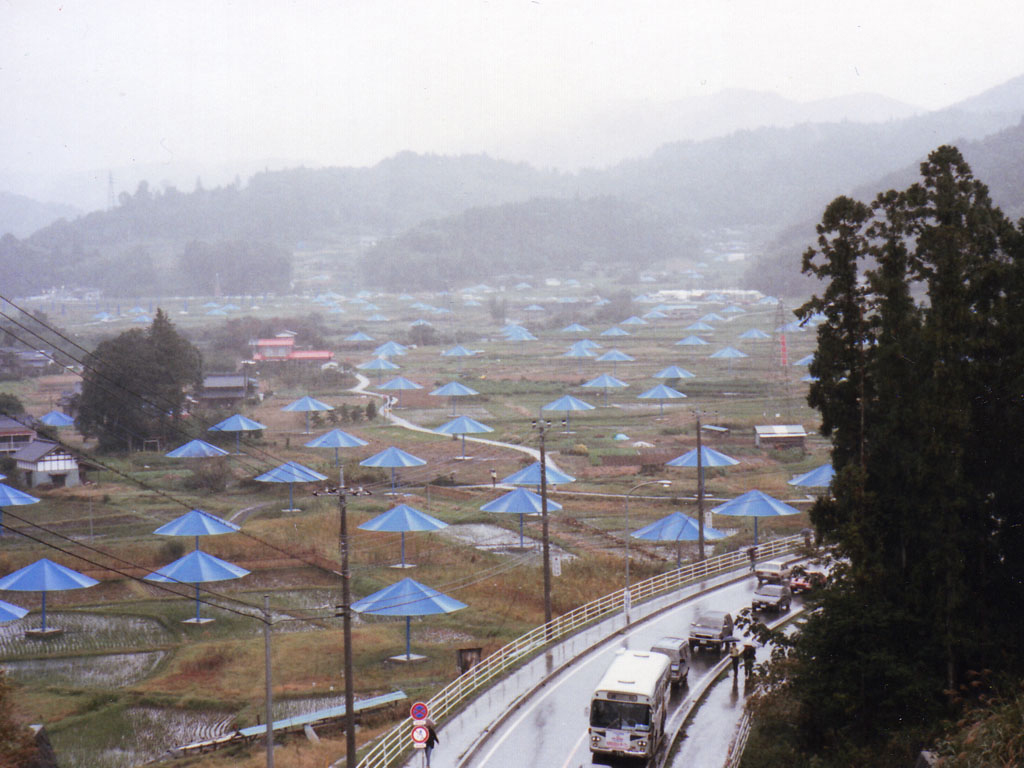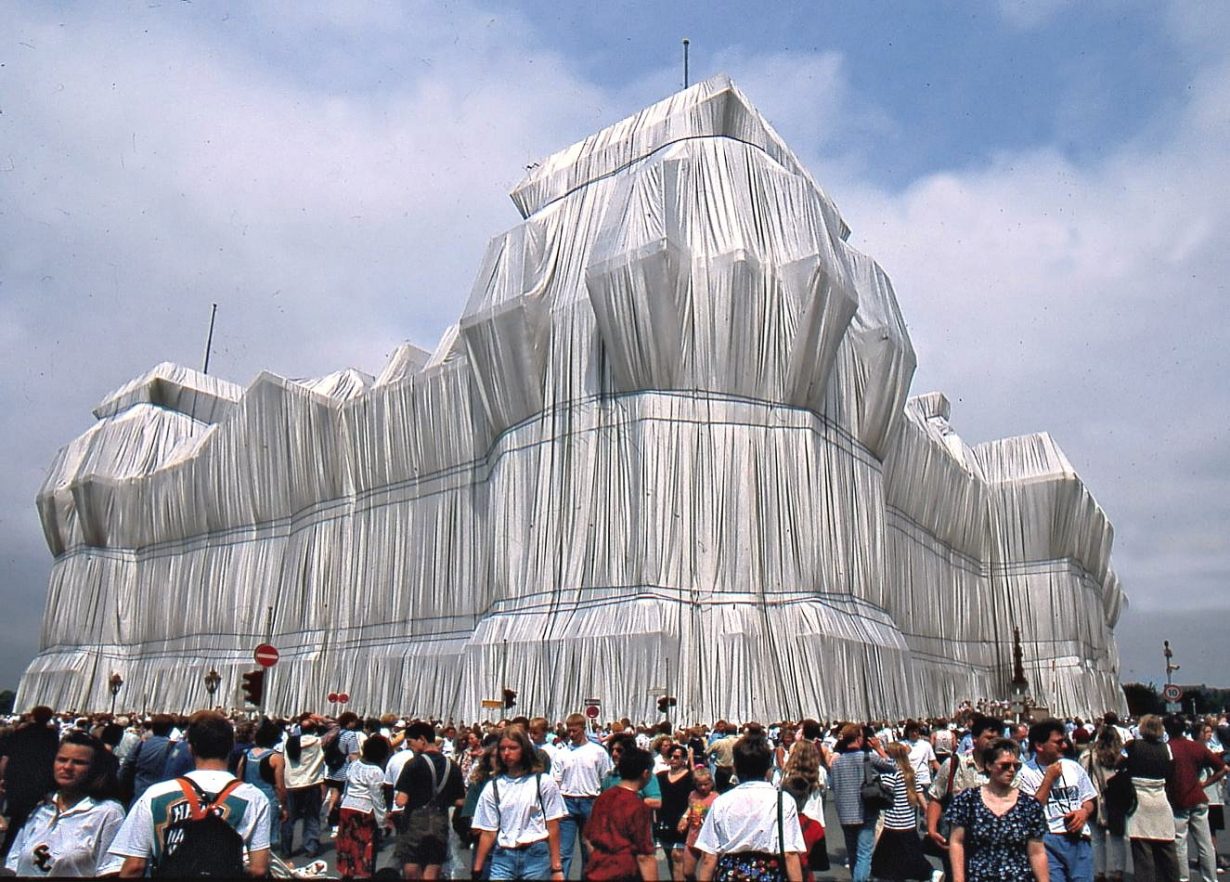‘It shows greater courage to make art temporary rather than permanent.’ In April 1995, David Lee met Christo and Jeanne-Claude as they prepared to wrap the Reichstag in Berlin…

What Christo does is improbable, nonsensical and, on the face of it, without rhyme, reason or function. In these respects it is a sign of the artistic times. Not only is it ridiculous even to conceive the idea of wrapping up Berlin’s Reichstag (imagine someone proposing to skinpack the Houses of Parliament and Big Ben in silver foil like some gigantic oven-ready turkey), it is even more astonishing, with the resistance to contemporary art being what it is, that he should think this sufficiently feasible to spend 25 years trying to achieve it. But here’s the piece de resistance: the most unlikely thing of all is that he actually manages to talk some of the most conservative creatures in existence (these have included American cowboys, right wing city mayors and Japanese rice farmers, as well as German MPs) into letting him have his way and do something so utterly utterly pointless. And it costs him a packet – $26 million dollars alone to erect blue and yellow umbrellas in Japan and California in 1993. His art is nothing if not a miracle of perseverance and persuasion, of constant badgering, lobbying and leafleteering. Perhaps the secret of his work is that in the end he just wears the opposition down to the extent that they roll over in submission.
Before starting I should explain that a year ago Christo became ‘Christo and Jeanne-Claude’ in recognition of his wife’s collaboration over the last thirty years; indeed, Jeanne-Claude, who is the chain-smoking daughter of a Gaullist general, devised the idea of surrounding eleven islands off Florida with pink fabric, a project carried out in 1983. As an indication of their equal importance, they never travel together on the same aeroplane: “Our son is a poet,” Jeanne-Claude explains. “He would not be able to take our place and sort everything out.” It was Jeanne-Claude, the organiser of the two, who asked me seriously at the beginning of our talk: “Do you want only art and philosophy or also human anecdotes?” It didn’t make much difference. Unfortunately for me, even after they have done a thousand interviews about the Reichstag project, such is their enduring enthusiasm for their work that they both answer questions at the same time. For the purposes of short- windedness and clarity I shall continue, therefore, to refer to the artist simply as ‘Christo’ while the answers are a combination of what both said, frequently in overlapping or, in good moments, alternate sentences. Jeanne-Claude, by the way, speaks English better than her husband who, considering he’s lived in New York for over thirty years, is still struggling with the fundamentals of syntax and pronunciation. Christo, who bobs up and down as he struggles to make a point and whose face sags like a spaniel’s, is probably one of those new nomads who speaks forty languages badly and none well. It is not always easy to follow his drift or the finer nuances of his argument.
My most enduring memory of a work by Christo is a short sequence from the film made about Running Fence, a fluttering white barrier some eighteen feet high which was erected across twenty five miles of Marin and Sonoma Counties of northern California in 1976. Following years of negotiations with farmers across whose land the fence ran, it was eventually built. As a species of art object never previously seen, and whose appearance could not therefore be anticipated, it looked shimmeringly beautiful in the sunset meandering up and down across the countryside. One fifty-something farmer was filmed weighing it up from a distance. He might have had BIGOT tattooed on his forehead but, instead, his bollard bulk, check uniform and rigid set of jaw was equally revealing. Shoving back his stetson, he scratched his temple and had to confess that in the light of the rising and setting sun it was real pretty. Almost against his wishes he conceded that he found it interesting and attractive, and, yes, he especially admired the workhands for having erected it so competently … even if, as he was quick to add, he would have done it differently himself. A neighbouring farmer liked the fence so much he slept in the open next to it. Game, set and match to Christo.

Christo’s latest project, the wrapping of the Reichstag in aluminium-coated polypropylene fabric (seventy tons) trussed with blue rope (six miles of it), takes place in June, having at last, and after three ‘final’ refusals, been given the go-ahead by the German Bundestag at the end of last year. The parliament debated Christo’s project for 70 minutes, the first time, Christo believes proudly, a work of art has ever been the subject of a debate in any national parliament. Despite the strong opposition of Helmut Kohl (who, come to think of it, is a dead ringer for that Californian rancher) the motion was passed. One hundred and eighty days of lobbying during the previous year had paid off. 1 asked them what they said to the German MPs, 350 of whom they lobbied individually, to convince them in favour of the project.
“The three points we make to them were first, that we are making a work of art. We show them our publications to show that all our projects are very outgoing, celebratory and visually exciting. They are joyful, not depressing because, unlike many contemporary artists, we are positive and optimistic. We explain to them also that the Reichstag will create this kind of energy, this kind of gathering.
“The second point we make is that we pay for the project ourselves. As with all our projects the money we make is not spent on cars or jewellery or houses in the Hamptons. There is no taxpayers’ money in our work.
“The third point is that all the materials are recycled. Nothing is wasted.”

The MPs’ main objections concerned the role the Reichstag has played in recent German history. It was built in 1894 and, contrary to popular belief, Hitler never spoke there, the building having been burnt down, probably on his instruction, only months after he came to power in 1933. Many Germans would like the Reichstag to be politely ignored and left undiscussed, it being too potent a reminder of an undemocratic past they’d rather forget. All such objections to Christo drawing the world’s attention to it are, the artist believes, equally good reasons for going ahead with the project.
The other reason, always an important one for proceeding with a project, is that they believe it will look beautiful. Jeanne-Claude expressed the view that in these hard times the Berlin scheme “will give some free joy to people”. The Reichstag aluminium material will ripple and dazzle. It will act not as a tight skin over the building, rather its looseness will allow for a kaleidoscopic effect of burning highlights and shadows. “It will shimmer in the wind,” promises Christo, “like a living object moving with the breeze.” Inevitably, and even though they have had a secret dry run on a castle in northern Germany, they can’t predict precisely what it will look like, but they have never been disappointed with the surreal, disarmingly beautiful effect their work usually creates. Whatever the visual impact, the reality of a parliament building, wrapped up, concealed, untouchable, imprisoned, is an idea which will provoke reams of conceptual comment in art magazines and papers. The Reichstag project has every chance of becoming the most widely debated, reported and illustrated work of art this century.
In the strangest of coincidences, on the same day – June 13th, 1935 – that Jeanne-Claude de Guillebon was born in Casablanca, Javacheff Vladimirov Christo was born in Grabovo in Bulgaria. His father was a textile factory owner and his mother was the general secretary of the art academy which Christo later attended. He was brought up under communism and, in order to win college credits, he had to paint illusionistic landscapes along the 450-mile route of the Orient Express press and to ensure that all the latest farm machinery was positioned prominently alongside the track in order convince passengers not only of the beauty of Bulgaria but of its industrial modernity and the well-being of its population. He escaped to Paris in 1956.

Once installed on the Ile St Louis, his training in socialist realism paid dividends and he made a living painting portraits of rich people, one of whom was Jeanne-Claude’s mother. He can’t explain why he started wrapping objects but this began slowly in the Sixties with small items, little more than ordinary looking parcels tied up with string. Most are now in museums. His ambitions were always much grander than mere Christmas presents and as early as 1961 he was making plans to wrap up a parliament building. 1968, annus mirabilis of student revolt and Abbey Road LP, saw the fruition of many cherished aims. He erected a temporary barricade on rue Visconti (this was an artistic rather than a political declamation), wrapped up a fountain at Spoleto in Italy and also wrapped up the Kunsthalle in Berne. His career since then is a roll-call of major projects, wrapping the Museum of Contemporary Art in Chicago and the coastline near Sydney (both 1969), The Valley Curtain, a huge orange dam in Colorado (1972), Running Fence (1976), the Pont Neuf in Paris (1985) and the Umbrellas project in California and Japan (1991). There have been many smaller schemes fitted in between. The next is likely to be a procession of saffron ‘gates’ along the paths in Central Park, New York (where the couple have lived since 1964) which has been in progress since 1980.
But what is the purpose of these works? American critic Robert Hughes expressed the opinion of many when he wrote that the artist’s high profile organisational skills seem to get in the way of appreciating the work itself. Christo would not be unhappy with such a view. He believes that the process by which permission to build a work is obtained is at least as important as the work itself. Millions of Germans, he points out, have (during what he calls the ‘software’ or discussion period of his work) so far debated the relative merits of an art work which doesn’t yet exist. However, he is also quick to state that beyond the creation of something beautiful and memorable (“We do it because we want to see it”), the objective is to force many people to consider the spaces, each with its distinct history, that they wish to use. For example, they have never used any place without strong human connotations and associations. Also, they want to break down preconceptions as to what in the late 20th century constitutes an art object: “I try to make people question what is art”. Christo is eager to emphasise yet another significant aspect of their work.

“The temporary nature of our project is important. Art is not immortal. We want to challenge the immortality of art by making work which is temporary but which lives on in the mind of those who saw it. It shows greater courage to make art temporary [rather] than permanent. All our projects have this self-effacing quality. It was here… and now it is missing. We borrow a space and we create a gentle disturbance for a short period. Our work, though durable, is vulnerable and we use cloth because it conveys this fleeting, nomadic quality of the work. All our projects challenge this idea of the immortality of art. My work can’t be bought, kept, controlled or possessed by anyone. When you spend so much money and get nothing back in the materialist, capitalist sense, this is not understood by people. They get confused.
“But, and this is very important, this project is also about freedom. It does not exist because President Kohl said yes – he said no actually – or because the mayor of the city or some corporate executive say yes, or because we have sponsorship from Coca Cola or American Express. The difficulty many have with our projects is because they are irrational and look pointless. Nobody can charge tickets to see them. Freedom is the enemy of possession and nobody can possess these works. Even financing the project ourselves is an aesthetical decision. We never accept money from anybody because we like to keep our freedom absolute.”
The only stage of the process in which Jeanne-Claude plays no part is the making of the drawings which are sold to finance the projects (the large drawings for the Umbrellas project cost $360,000). In the current exhibition at Annely Juda are included drawings, mounted as usual in perspex boxes and with collaged elements for the wrapped parts in order to emphasise the potential reality of the project. Interestingly, the Reichstag drawings, ranging over 25 years, document the changes in material and process as the project has developed. Christo is quick to point out that a project is not unchangeable from its inception but instead, evolves as negotiations take place and as his awareness of the location is altered by discussions with those directly involved.

Although the Reichstag is their latest project it has been planned for over a quarter of a century and is something of a throwback in their work. No project devised since 1980 has involved wrapping and they told me that the Reichstag is absolutely their last wrapped building. In recent projects work has been moving in the direction of opening rather than concealing, of dealing with areas that can be entered and journeyed through, such as the gates in Central Park and a relatively recent idea to build a canopy over a white water rafting river in the Rockies.
For the time being all of their attention is on Berlin, where between five and eight million people, the cumulative annual attendance of the Tate and National Galleries, are expected to converge in late June to see a mere artwork. “It will be very beautiful” Christo promises. “There is a place for such madness.”
First published in Art Review, April 1995